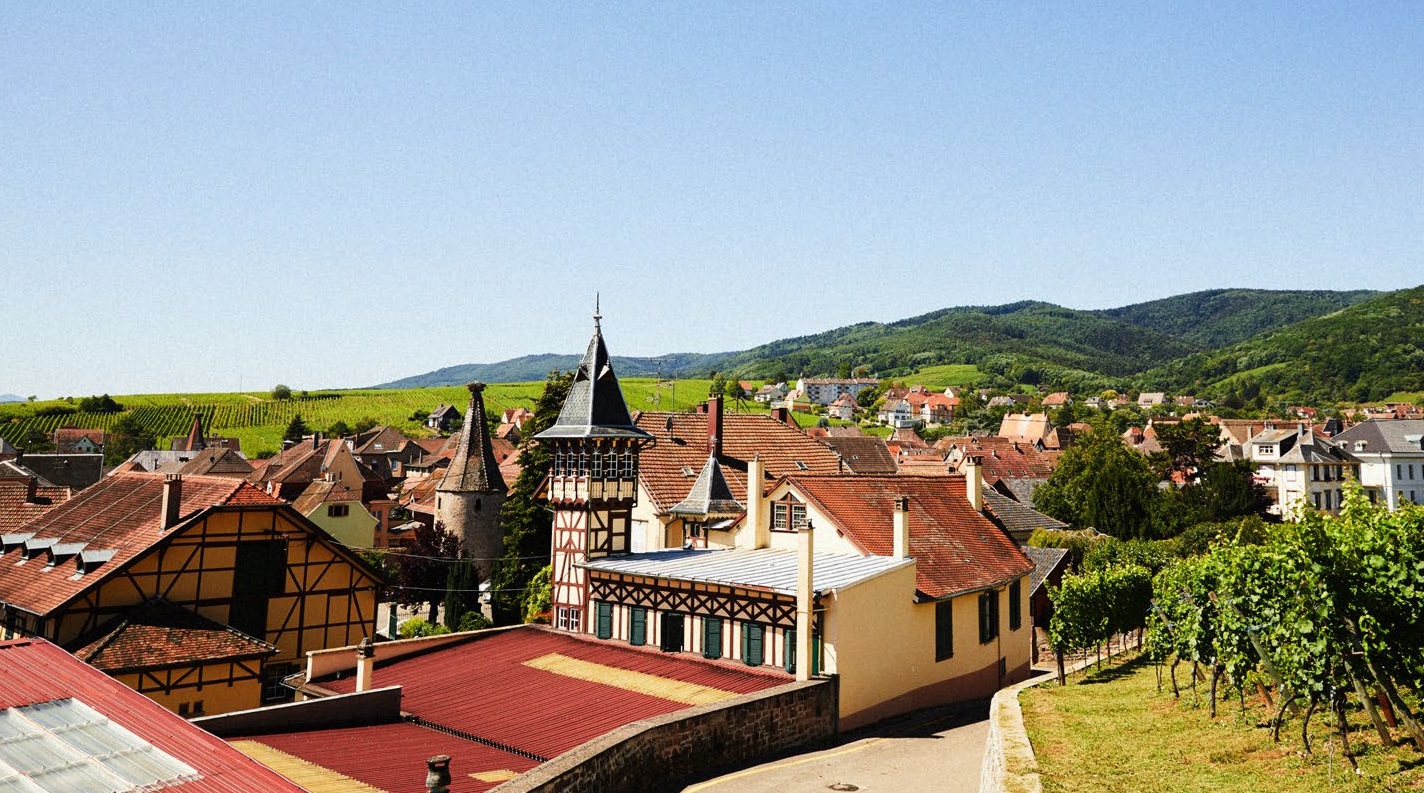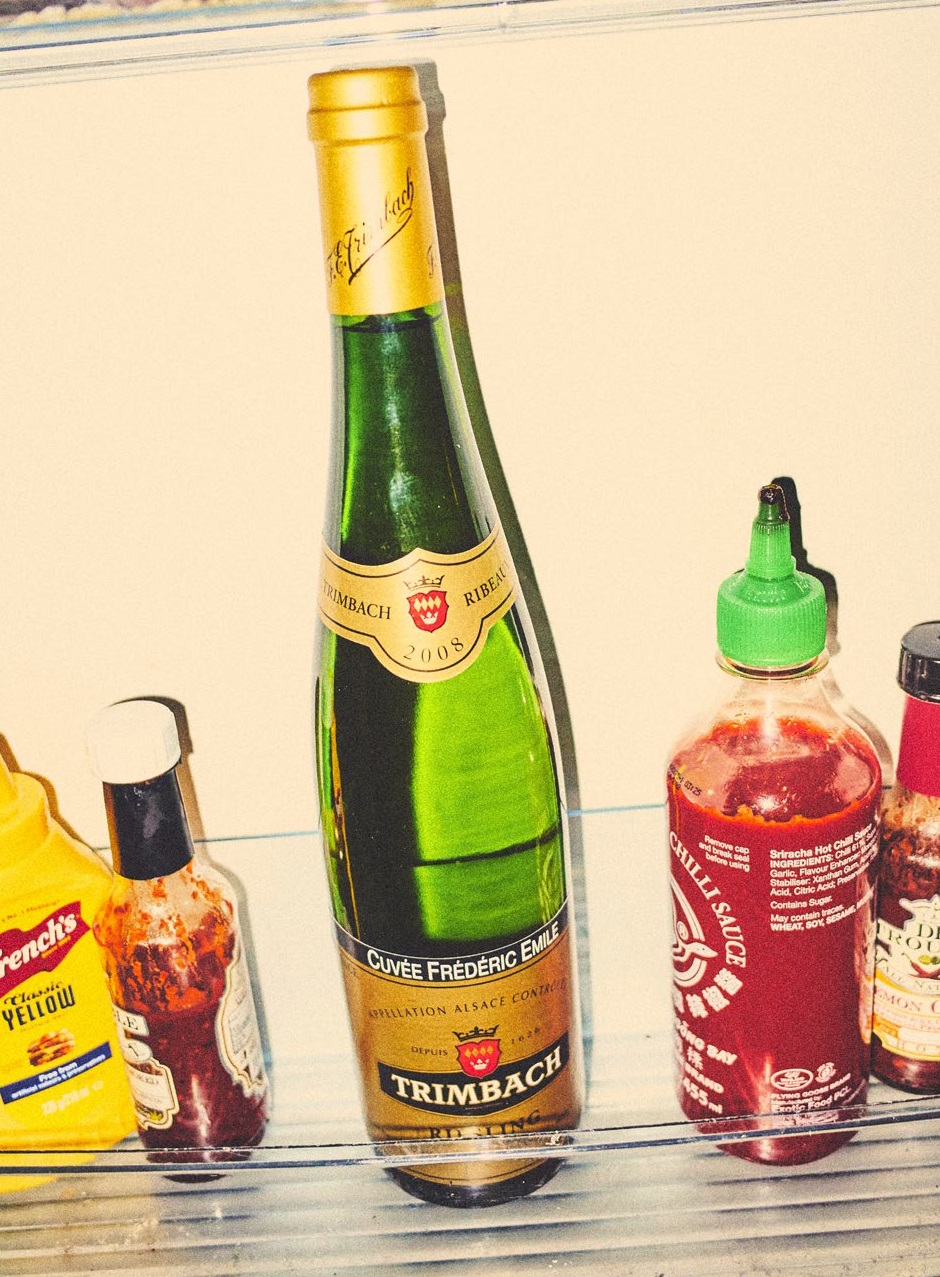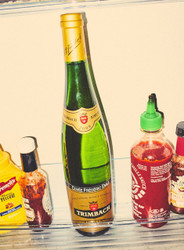Fred or Dead
Posted by Dan Keeling, Noble Rot Magazine, 29th July 2021 on 2 Jul 2021
Dan Keeling on Alsace’s quintessential Riesling, Maison FE Trimbach ‘Cuvée Frédéric Emile’
Have you ever been the schmuck who mistakenly orders a bottle of sweet-as-marmalade Sauternes in a restaurant at the beginning of a meal? Or ‘creates’ a dish as heinous as ‘chilli pepper soup’, the only thing you can ‘cook’ at home, by adding copious quantities of chopped red chilli and ground black pepper to the Knorr Chicken Noodle variety? Friends, I’m ashamed to admit to such indiscretions. But there came a time when I finally woke up to gastronomic self-improvement and began taking an interest in something other than just the next weekender, or who’s headlining Saturday at Glastonbury. ‘Replacing the rave’ happens to almost all of us in one way or another, whether it means spending your mornings fannying around on the golf course, or reimagining yourself as a reiki master. And so it was, in 2007, that my wife and I enrolled at Leiths Cookery School and on Christie’s Wine Course in London to begin our re-education.

My cookery skills may once have been as lacking as the family-planning section of a Catholic pharmacy but Leiths gave us quick kitchen confidence, teaching us how to dice an onion while also allowing us to make lifelong friends. Christie’s, too, was a fabulous introduction to something that, unbeknown to me then, would become a second métier. Although at the time I had little idea who course tutors Michael Broadbent and Steven Spurrier were, looking back I now feel as privileged as someone who had been taught physics by Albert Einstein, or shown how to build a Camberwell Carrot by Withnail’s pal Danny. These debonair old-timers had an air of relaxed conviviality derived from the enjoyment of the finer things in life, and what they didn’t know about the great wines of the world you could write on the bottom of a Château Mouton Rothschild cork.
Working with us through classic regions, styles and grape varieties over six weekly evening classes, Broadbent and Spurrier often bamboozled the congregation of trainee actuaries and rosy-cheeked Sloanes with inappropriate details (“on the 16 April 2004 hail decimated part of the vineya… “ Zzzzz). But they encouraged my burgeoning interest in wine by adding dimensions to famous names through constant tasting, especially with their choice of benchmark Alsace Riesling – the entry cuvée from Maison FE Trimbach. I remember the revelation of putting my nose in glass as if it were yesterday, the pale liquid’s familiar odours of petrol and green apple transporting me straight to my motor-mechanic father’s oily restoration workshop as a child, and hotwiring a connection between the word ‘Riesling’ and the evocative taste sensation I’d experienced several times before without ever knowing what it was called. Back in the present, and although my taste has evolved, I still think that Maison FE Trimbach makes the quintessential dry Alsace Riesling. Like a childhood crush, I’ll always have a soft spot for its basic cuvées’ canary-yellow label and angular bottle: if I were asked to recommend one inexpensive, widely available white for someone beginning to explore wine, this could be it. But, for a few pounds more, the Trimbach wine I really want to drink is ‘Cuvée Frédéric Emile’, Trimbach’s next notch up, which I discovered soon after finishing Christie’s, a Riesling that has been the gateway to infatuation for generations of winos. Of course, the house also produces the iconic ‘Clos Sainte Hune’, which some critics even cite as the best wine in the world of any kind (Jancis Robinson picked the 1990 as part of her hypothetical ‘last supper‘in Noble Rot 7), as well as other single-vineyard Rieslings, and the local specialities Pinot Gris and Gerwürztraminer. But for me ‘Cuvée Frédéric Emile’ hits the bull’s-eye of affordability, ageability and deliciousness. It’s the rare mainstream white wine that can appeal as much to a total beginner as the jaded aficionado.
Maison Trimbach is based in an ancient half-timbered building in fairy-tale Ribeauvillé, close to the Rhine and France’s border with Germany, and is headed by brothers Jean and Pierre Trimbach, the 12th generation of the family to run the domaine since it was founded in 1626. “I like to say that we kept the good things about Germany – the discipline and the sausages,” says Jean, an eccentric who I imagine terrorising unwitting exchange students with a sense of humour even drier than his wines. Indeed, this border region has a long history of occupation, a blurry hybrid of French and German aesthetics and culture that, ironically, has long seen the locals viewed with suspicion by either side; not Germanic enough for the Germans, nor French enough for the French. The stylistic overlap also extends to the local cuisine: oodles of sausages, cured meat, sauerkraut and specialities such as baeckeoffe (‘baker’s oven’) and choucroute garnie – all hearty foundations for long afternoons exploring the surrounding hillsides and mountains that pair brilliantly with the richness and acidity of ‘Cuvée Frédéric Emile’, even though it’s a white.

Frédéric Emile references the ‘FE’ in Maison FE Trimbach, an ancestor who did much to develop the domaine’s expertise and reputation. The wine is made from grapes grown in two steep Grand Cru vineyards overlooking the Ribeauvillé winery – south-facing Geisberg (which has stony clay and sandstone soils) and east-facing Osterberg (stony clay and marl). The different parcels are vinified separately in an array of steel, concrete and wood vessels, then blended together by winemaker brother Pierre. But like its lofty sibling ‘Clos Sainte Hune’, ‘Cuvée Frédéric Emile’ doesn’t reference vineyards on its label, a hangover from the domaine’s long-held frustration with what it perceived as Alsace’s lax rules for classifying Grand Crus, something that has now been remedied by the AOC setting new requirements for minimum alcohol levels, maximum yields, and so on. Besides, a lack of accreditation has ever-dented demand for such consistently brilliant wines. Frédéric Emile isn’t just one of the most iconic Rieslings in Alsace, it’s one of the most iconic white wines in the world,” says Jean, dwarfed by 10,000-litre old oak casks in the family cellars. “When people talk about it they don’t say ‘Riesling’ any more – they say Frédéric Emile, or Freddie E, or CFE. I’ve heard so many nicknames for it.” He’s justified such swagger; when strangers start giving affectionate acronyms to your work you know you’re doing something right. One of the reasons such a deep admiration has developed for ‘Cuvée Frédéric Emile’ is because of the wine’s potential to evolve over many years.

And, unlike more ‘made’ fine wines – that is to say those that are overly manipulated in the winery to correct ‘deficiencies’, obscuring interesting vintage variations – every year has something different to say. Having not drunk ‘Cuvée Frédéric Emile’ for a while, I opened several bottles and prayed to Bacchus they’d live up to my memories. I needn’t have worried as a couple even surpassed them – a neat trick given that trying to replicate the thrill of past wines so often proves futile. An attractive aroma of petrol – not something all Riesling have – is a signature. They were also all uncompromisingly dry – even when the smell of ripe fruits suggested residual sweetness – and had a zippy acidity balancing their inherent richness. More specifically, the streamlined 2011 had lovely clarity and length and was just beginning to enter its prime; the 2008 was a bit looser, with a more muddled tropical/vegetative profile; the sublime, harmonious 2007 tasted like biting into a crisp red apple, balancing Alsace’s roundness with stony freshness; and the golden-coloured 2000 was a fabulous advert for this cuvée’s longevity. Contrasting an opulent perfume of late-summer stone fruits and candied orange pith with a saline, austerely dry finish, it had lovely freshness for such a warm vintage.
But as much as drinking ‘Cuvée Frédéric Emile’ is a reliably satisfying end in itself, it has also been my gateway to discovery. It energised me to begin looking for connections to other great Rieslings, beginning at top Alsatian domaines such as Weinbach, Josmeyer and Zind-Humbrecht (whose wines I found harder to tell whether they were dry or off-dry – a wider source of frustration that some drinkers have with the region), and on to German masters such as Egon Müller, Joh Jos Prüm and my all-time favourite, Klaus Peter Keller. It can also save the day when faced with a mediocre restaurant wine list: ‘Cuvée Frédéric Emile’ is a classic produced in large enough quantities that there’s often a stray bottle or two to be plucked from among the generic, commercial brands. Like those happy times discovering wine at Christie’s with Michael Broadbent and Steven Spurrier – both of whom have sadly died over the last 18 months – I know I’m in the safest of hands.

